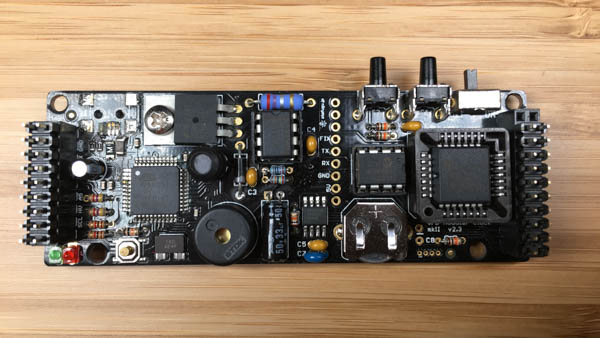IV-11/6 6-Digit Shield Parts List
The IV-11/6 6-digit shield comes with the following parts:
- 1x IV-11/6 PCB with half-cut holes for easy tube assembly
- 4x IV-11 numeric display tubes
- 2x IV-6 numeric display tubes
- 2x 68Ω resistors
- 2x 3.3V regulators
- 1x 2x9 pin male header
- 1x 2x10 pin male header
IV-11/6 6-Digit Shield Assembly
Step 1a
First take some time to familiarize yourself with the PCB. The pins of each of the six IV-6 VFD tubes slide through the six holes in the PCB.
Here is the PCB:
TOP:

BOTTOM:

Tubes:

PCB shown with other included parts:

Step 1b
Solder the two resistors, they are both identical 68Ω resistors.
Bend the legs and insert one resistor into each pair of holes marked 68Ω . They insert from the bottom of the board, so that the actual resistor fits over the text. Bend each of the legs outward and turn the board over to solder all the legs. Once that is done, clip off the excess parts of the legs.


Step 1c
We will now insert the two 3.3V voltage regulators from the bottom of the board. Make sure the regulators are inserted properly: The half-circle drawing on the board should match the half-circle shape of the regulator.
Turn the board over to solder, and then clip off the excess part of each leg.

PS: To the left of each of the two spaces for the voltage regulators, there are two headers that can house ceramic capacitors. These capacitors are optional, and are not included in the kit. They can optionally be populated with 0.1µF and 1µF ceramic capacitors.
Step 1d
Insert the 2x9 and 2x10 male headers into the base board as shown in the image.

Note that the header on the right has 11 rows on the base board, the top row is not used for this sheild.
Step 1e
Place the shield on top of the pins you just inserted into the base board, and push down, making sure to align everything properly.
The shield will stick out to the left side of the base board.

Now solder all the legs in place.

After soldering all the legs, remove the shield form the base board.
Step 1f
The next step is to insert and solder the 4 IV-11 tubes and the 2 IV-6 tubes. They can be soldered in any order.
Each tube should be inserted from the top of the board (the side that says VFD Modular Clock). Align each tube so that the front of the tube points towards the front.
Rotate the tube so that it's orientation matches the gap. Gently press all the legs of the tube together so that it slides easily through the hole. Press it slowly downward.

Now turn the board upside down and using either your fingers or tweezers pull each leg outward so that it touches against the hole where it is to be soldered.
It is possible to push each tube all the way in so that it rests against the PCB. You can do this for both IV-11 and IV-6 tubes.
You can also push the IV-11 tubes all the way in and leave a small gap for the IV-6 tubes, as this may give a more balanced look betwen the large IV-11 tubes and the small IV-6 tubes.
Either configuration will work if you are planning to use the enclosure we sell in our shop.
If you plan to build your own enclosure, you should consider if the design works better with a gap or not.

The pictures below shows the soldered tubes with legs clipped.




Step 1g
Once you are done soldering, it is time to mount the shield back on top of the base board, the same way you did when you soldered the male headers.
Congratulations, you have now finished assembling the IV-11/6 display shield.
Before using it you may want to insert the four nylon spacers underneath the base board and gently screw in the nylon screws from the top. (when removing the display shield, pull slowly on each side and be careful not to bend the legs or warp the PCB). The nylon spacers are not used when you use the board in our enclosure.
When you turn on power, the shield will be autodetected as an IV-6 shield. This is normal.
Now Head over to the usage page for instructions on how to set the time.